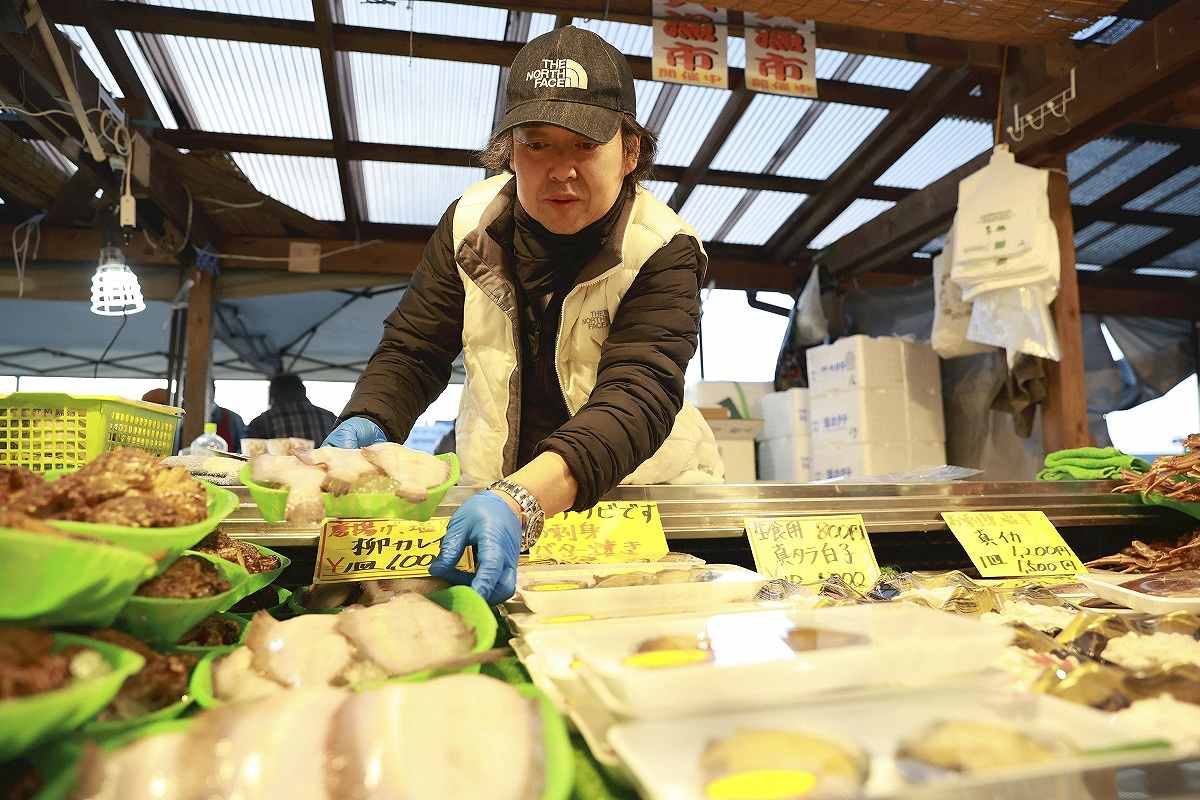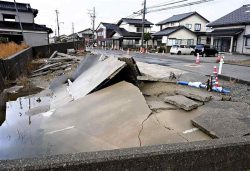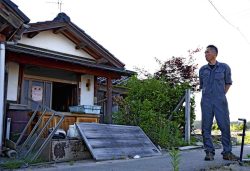Rebuild of Yuriage Market in Tohoku Offers Lessons for Wajima; Market Seeing More Traffic Than Before 2011 Quake

Nagatake Tomizu, left, and Koiki Sakurai walk down a once bustling street that was home to the Wajima Morning Market in Wajima, Ishikawa Prefecture, on Feb. 19.
7:00 JST, March 10, 2024
Only the frames and outer walls of buildings remained, and burnt debris littered the ground. Gone were the stores selling seafood and lacquerware that used to line the street; gone was the bustle of a district that was one of the three major morning markets in Japan. The Noto Peninsula Earthquake had left the market in Wajima, Ishikawa Prefecture, changed been beyond recognition.
On Feb. 19, 1½ months after the quake, Koiki Sakurai, 69, representative director for the Yuriage morning market cooperative association in Natori, Miyagi Prefecture, was in the disaster area in Wajima, which had been gutted by a massive fire triggered by the quake.
“Yuriage’s market also started from scratch,” Sakurai said, recalling the 2011 Great East Japan Earthquake and tsunami.
At 2:46 p.m. on March 11, 2011, Sakurai felt shaking at his home in the Yuriage area, near Sendai Bay, that measured upper 6 on the Japanese seismic intensity scale of 7. The radio warned of a tsunami. He hurriedly drove to his sister’s house up on higher ground. The next day, when he headed back to Yuriage, he found the vast flat land had been swallowed by the sea.
“The morning market is no longer viable,” Sakurai told himself.
The market in Yuriage was established spontaneously in the late 1970s mainly by a group of local seafood processors. It was beloved as “the community’s kitchen,” offering locally cultivated seafood, vegetables and other food, but the tsunami swept away all 50 stores. Five people including shop owners were also killed.
At evacuation centers, regulars to the market were in need of food, and the cooperative association had ¥20 million in its account.
“It would be hard to reopen the morning market, so let’s use this money to repay our customers,” Sakurai thought. He consulted with other cooperative association members, and they took trips to wholesalers and supermarkets in Yamagata Prefecture to purchase food, which they distributed to evacuation centers every day.
Half a month later, on March 27, 2011, they held a one-time morning market in the parking lot of a supermarket about five kilometers inland from Yuriage. They wanted plenty of people to be able to get food. Many customers shook hands with the cooperative association members and expressed their thanks. Some residents, seeing each other for the first time since the disaster, cried and hugged each other.
Though he was glad to experience this community once more, Sakurai intended this to be the end of the market.
The next day, Sakurai received a call from the Natori city government. “The phone lines at the city hall are jammed with people asking when the next morning market will be held. Please do something about it,” he was told.
The “one-time” market turned into a weekly event, held in the same supermarket parking lot.
The question was how to secure the funds to the restart the market properly, but they were able to get ¥124 million in assistance from a Canadian project supporting reconstruction. On May 4, 2013, the Yuriage morning market reopened at its original location.
Sharing trials, successes

Shigetomo Tomita has taken over his parents’ business and vowed to improve the Yuriage morning market, a symbol of the region’s recovery.
When the Yuriage market’s reopening was making headlines in the region, Shigetomo Tomita, now 55, announced he would take over from his father, Tomomichi. “I had no choice but to do the job myself,” Shigetomo recalled.
Tomomichi, who died in 2022 at 82, quit his job as a company employee to open a fish shop with his wife Akiko. When morning market was first established. On March 11, 2011, Tomomichi and Akiko, who were at home after preparing for the market, fled to escape the tsunami and were separated. Akiko,67, was killed by the wave. Grieving over his inability to save her, Tomomichi cried and grew depressed.
Shigetomo grew up watching his parents work themselves hard in the fish shop. He couldn’t bring himself to let the business die after the quake, so he opened a shop at the restored morning market.
Though Shigetomo originally worked for an architectural firm, he gained little experience, sometimes helping out with heavy physical work. As he is left-handed, he had a hard time cleaning fish. He sometimes misjudged customer demand and ended up with as many as 300 scallops left over. However, after some trial and error based on data, he gradually learned how to get everything sold, such as by arranging items to improve sales and setting up a space to grill fresh seafood.
“Reconstruction will be with me for the rest of my life,” he said. “But my desire to improve the morning market is what keeps me going.”
The revived Yuriage market did not necessarily go well from the start. It was not easy to attract customers to a place that was so badly damaged by the tsunami. The houses that used to line the surrounding area, and where many of the market’s regulars lived, were all gone. Even so, all the shopkeepers set out to devise new ways to attract customers, such as by holding auctions for customers to participate in. The market is now held every Sunday and attracts about 5,000 people, more than before the earthquake.
Meanwhile, the Wajima Morning Market is also trying to move forward. On March 23, the first off-site market is expected to be held in Kanazawa, and after April, organizers are considering holding the market at other locations in Wajima.
Sakurai, on his visit to Wajima, handed over ¥242,000 donated by members of the Yuriage market cooperative association to Nagatake Tomizu, head of the Wajima market cooperative association, and told Tomizu about his association’s struggle to revive their market in the 13 years since the disaster.
“The appeal of a morning market is that people can connect. I hope our experience in Yuriage will be of some help,” Sakurai said.
In response, Tomizu said, “I was encouraged by the existence of the Yuriage market, which really rose up from nothing.”
The hard work of rebuilding can be turned into a source of strength for someone else.
"Society" POPULAR ARTICLE
-

M4.9 Earthquake Hits Tokyo, Neighboring Prefectures
-

M7.5 Earthquake Hits Northern Japan; Tsunami Waves Observed in Hokkaido, Aomori and Iwate Prefectures
-

Israeli Tourists Refused Accommodation at Hotel in Japan’s Nagano Pref., Prompting Protest by Israeli Embassy and Probe by Prefecture
-

Tsukiji Market Urges Tourists to Avoid Visiting in Year-End
-

M5.7 Earthquake Hits Japan’s Kumamoto Pref., Measuring Upper 5 Intensity, No Tsunami Expected
JN ACCESS RANKING
-

Keidanren Chairman Yoshinobu Tsutsui Visits Kashiwazaki-Kariwa Nuclear Power Plant; Inspects New Emergency Safety System
-

Imports of Rare Earths from China Facing Delays, May Be Caused by Deterioration of Japan-China Relations
-

University of Tokyo Professor Discusses Japanese Economic Security in Interview Ahead of Forum
-

Japan Pulls out of Vietnam Nuclear Project, Complicating Hanoi’s Power Plans
-

Govt Aims to Expand NISA Program Lineup, Abolish Age Restriction




















